Ethereum
Has the Ultra Sound Money Era Ended?
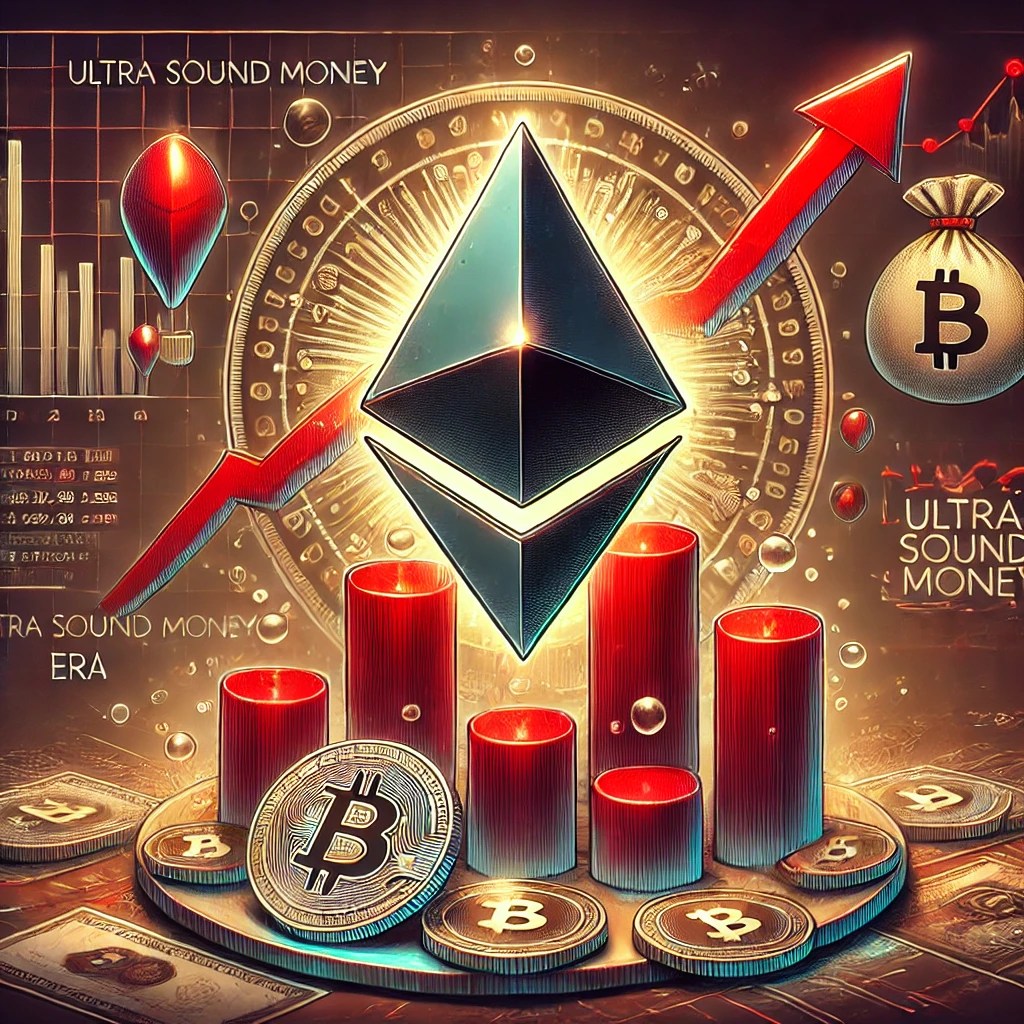
Ethereum (ETH) which is addressed as ultra-sound money due to its deflationary supply method, now appears to be facing new challenges that have prompted some analysts to question whether this narrative still holds.
A prominent crypto analyst, Thor Hartvigsen, recently highlighted this issue in a detailed post on X, where he discussed the current state of Ethereum’s fee generation and supply dynamics.
Is ETH No longer Ultra-Sound money?
Hartvigsen pointed out that August 2024 is “on track to be the worst month in terms of fees generated on the Ethereum mainnet since early 2020.” This decline is largely attributed to the introduction of blobs in March, which allowed Layer 2 (L2) solutions to bypass paying significant fees to Ethereum and ETH holders.
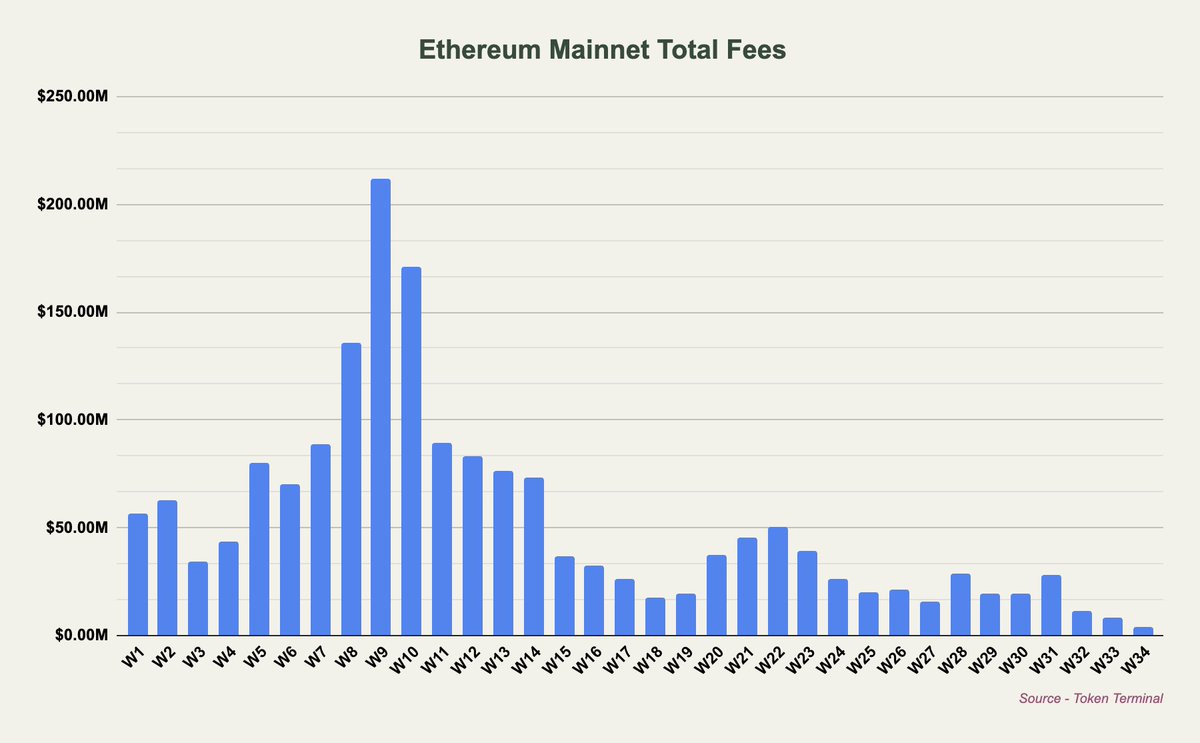
As a result, much of the activity has shifted from the mainnet to these layer two (L2) solutions, with most of the value being captured at the execution layer by the L2s themselves.
Consequently, Ethereum has become net inflationary, with an annual inflation rate of approximately 0.7%, meaning that the issuance of new ETH currently outweighs the amount being burned through transaction fees.
Hartvigsen disclosed the impact of this on Non-Stakers and Stakers: According to the analyst, non-stakers primarily benefit from Ethereum’s burn mechanism, where base fees and blob fees are burned, reducing the overall supply of ETH.
However, with blob fees often at $0 and the base fee generation decreasing, non-stakers are seeing less benefit from these burns. At the same time, priority fees and Miner Extractable Value (MEV), which are not burned but rather distributed to validators and stakers, do not benefit non-stakers directly.
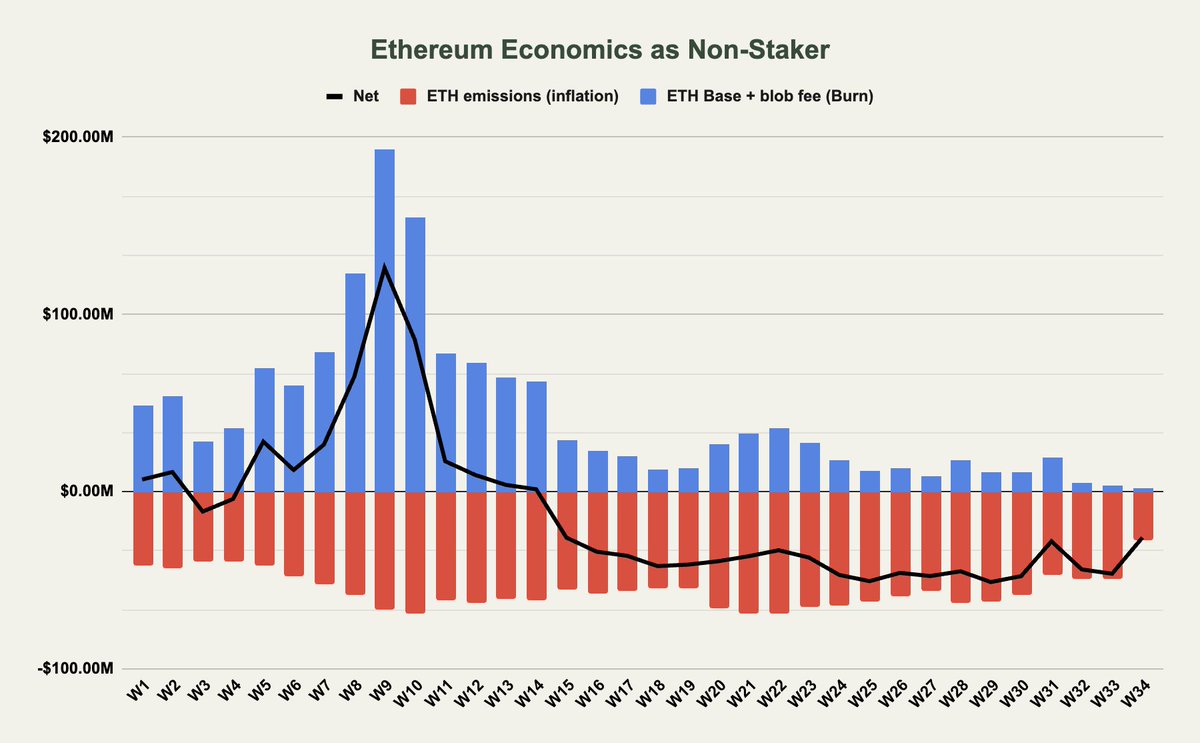
Additionally, the ETH emissions that flow to validators/stakers have an inflationary effect on the supply, which negatively impacts non-stakers. As a result, the net flow for non-stakers has turned inflationary, especially after the introduction of blobs.
For stakers, the situation is somewhat different. Hartvigsen revealed that stakers capture all the fees, either through the burn or via staking yield, meaning that the net impact of ETH emissions is neutralized for them.
However, despite this advantage, stakers have also seen a significant drop in the fees flowing to them, down by more than 90% since earlier this year.
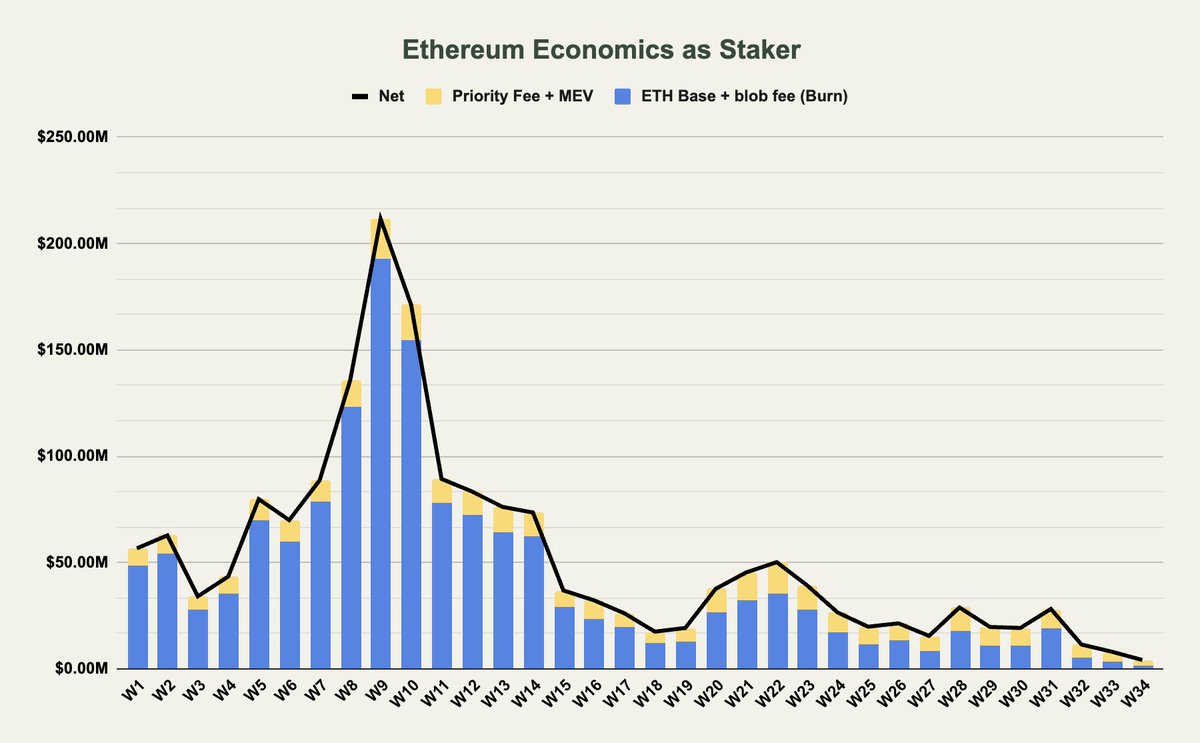
This decline raises questions about the sustainability of the ultra-sound money narrative for Ethereum. To answer that, Hartvigsen sated
Ethereum no longer carries the ultra sound money narrative which is probably for the better.
What’s Next For Ethereum?
So far, it is quite evident with the current trends that Ethereum’s ultra-sound money narrative may no longer be as compelling as it once was.
With fees decreasing and inflation slightly outpacing the burn, Ethereum is now more comparable to other Layer 1 (L1) blockchains like Solana and Avalanche, which also face similar inflationary pressures, says Hartvigsen.
Hartvigsen notes that while Ethereum’s current net inflation rate of 0.7% per year is still significantly lower than other L1s, the decreasing profitability of infrastructure layers like Ethereum may necessitate a new approach to maintaining the network’s value proposition.
One potential solution the analyst discussed is increasing the fees that L2s pay to Ethereum, though this could pose competitive challenges. Concluding the post, Hartvigsen noted:
Zooming out, infra-layers are in general unprofitable (study Celestia generating ~$100 in daily revenue), especially if viewing inflation as a cost. Ethereum is no longer an outlier with a net deflationary supply and, like other infra-layers, require another way to be valued.
Featured image created with DALL-E, Chart from TradingView
Ethereum
Why A Massive Drop To $1,400 Could Rock The Underperformer

Reason to trust

Strict editorial policy that focuses on accuracy, relevance, and impartiality
Created by industry experts and meticulously reviewed
The highest standards in reporting and publishing
Strict editorial policy that focuses on accuracy, relevance, and impartiality
Morbi pretium leo et nisl aliquam mollis. Quisque arcu lorem, ultricies quis pellentesque nec, ullamcorper eu odio.
Crypto analyst Klejdi has indicated that Ethereum’s pain is far from over, with the second-largest crypto by market cap set to suffer a further downtrend. Specifically, he warned that ETH could still drop to as low as $1,400 before it finds a bottom.
Ethereum May Still Drop To As Low As $1,400
In a TradingView post, Kledji stated that Ethereum may drop to $1,400, providing a bearish outlook for the altcoin, which has underperformed other top cryptocurrencies. The analyst noted that ETH lost nearly 12% of its value within just three days after breaking out of its recent pattern last Friday.
Related Reading
He further mentioned that Ethereum’s movement and the rest of the crypto market are closely tied to Bitcoin. As such, this ETH crash is likely to happen, seeing as the flagship crypto has dropped to $81,300 and is already showing signs of further decline.
Klejdi highlighted in his accompanying chart that ETH will likely consolidate near its current level before continuing to move lower. However, the chart showed that the move to this $1,400 target will likely happen this month.
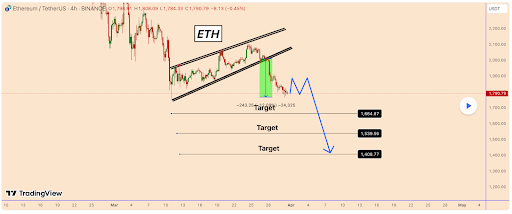
In the meantime, the analyst believes it would be wise to wait for Ethereum’s price to form another bearish pattern before entering a trade. He again reaffirmed that there is a strong possibility that ETH may extend its drop to $1,400.
Ethereum whales are already capitulating ahead of this projected price crash. Onchain analytics platform Lookonchain revealed an ETH OG that has sold off all its holdings. This investor bought 5,0001 ETH while trading at $277 in 2017 and didn’t sell when the altcoin hit its ATH during the last bull run. The whale started selling last month, possibly giving up on Ethereum making a comeback anytime soon.
ETH Will Still Reach New Highs
Crypto analyst Virtual Bacon is still confident that Ethereum will reach new highs. He noted that ETH is back at its key bear market breakout zone, retesting the $1,700 and $2,100 range. He predicts that the altcoin will continue to chop around this range in the short term. However, he remarked that Ethereum tends to catch up fast once the US Federal Reserve pivots and global liquidity turns.
Related Reading
Crypto analyst Crypto Patel affirmed that Ethereum’s biggest run is coming. He stated that Q2 to Q4 of this year will be life-changing for ETH. The analyst added that this could be the cycle top window and advised market participants not to miss it. Crypto Patel advised that they should accumulate between $1,900 and $1,300 with the target of between $7,000 and $10,000 in mind.
At the time of writing, the Ethereum price is trading at around $1,850, up in the last 24 hours, according to data from CoinMarketCap.
Featured image from iStock, chart from Tradingview.com
Ethereum
Whales Dump 760,000 Ethereum in Two Weeks — Is More Selling Ahead?
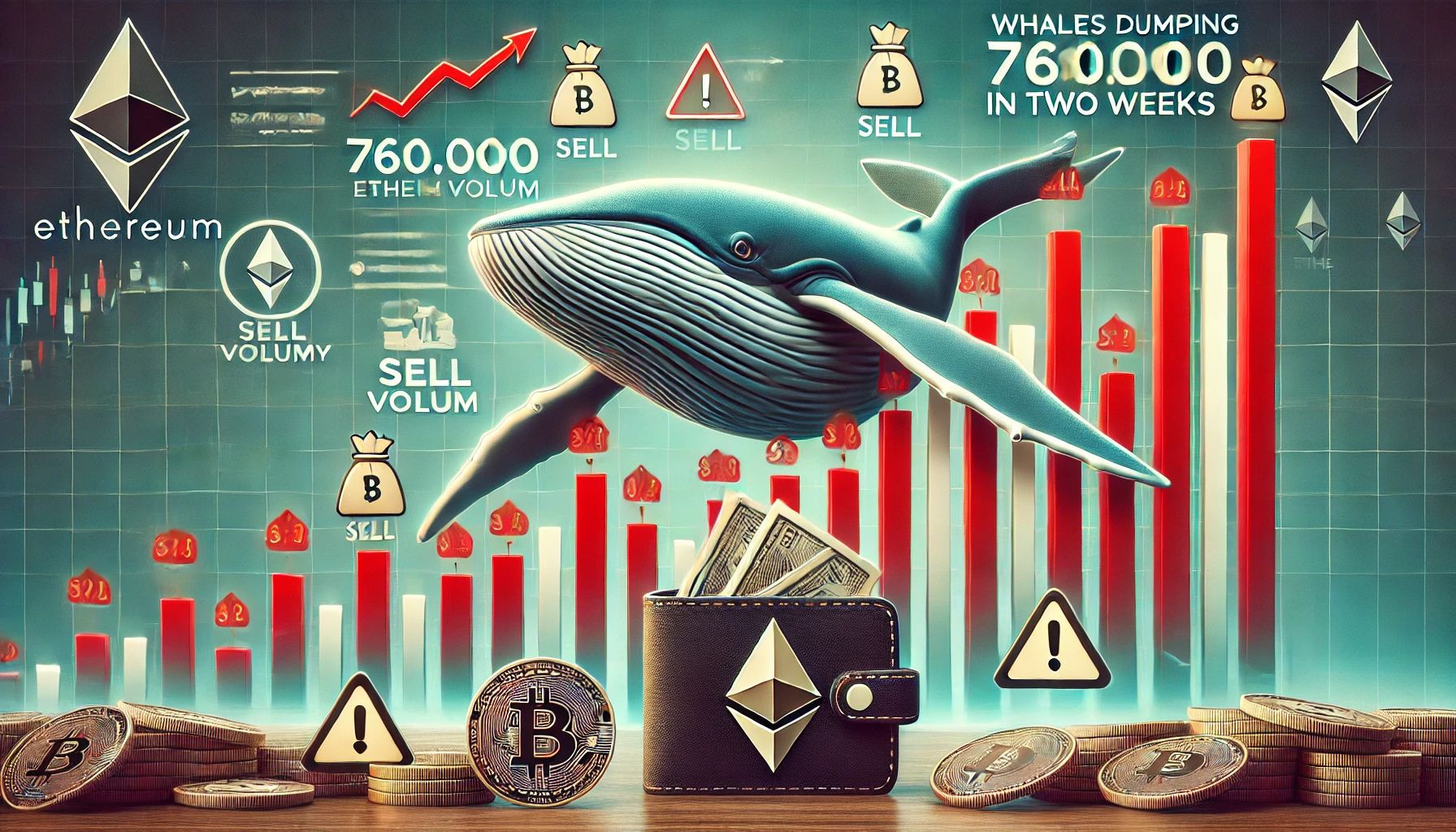
Reason to trust

Strict editorial policy that focuses on accuracy, relevance, and impartiality
Created by industry experts and meticulously reviewed
The highest standards in reporting and publishing
Strict editorial policy that focuses on accuracy, relevance, and impartiality
Morbi pretium leo et nisl aliquam mollis. Quisque arcu lorem, ultricies quis pellentesque nec, ullamcorper eu odio.
Ethereum continues to face strong headwinds as it trades below the $1,900 mark, with bullish momentum fading and market sentiment growing increasingly fearful. After a brief attempt to stabilize, ETH has resumed its downward trajectory, now down over 35% since late February. Price action remains weak, and investors are bracing for more potential downside as selling pressure shows no sign of easing.
Related Reading
Contributing to the bearish outlook, on-chain data from Santiment reveals that whales have offloaded approximately 760,000 ETH in just the past two weeks. This significant sell-off by large holders adds weight to the growing concerns that the market may be entering a deeper correction phase. When whales exit in size, it often reflects declining confidence and triggers a wave of additional selling from smaller investors.
With macroeconomic uncertainty still shaking financial markets and Ethereum’s key support levels under threat, the outlook for ETH remains fragile. Bulls must act fast to reclaim momentum and prevent a slide into lower demand zones. Until then, the combination of fading demand, technical weakness, and aggressive whale selling continues to cloud Ethereum’s near-term path, leaving traders on edge as the next move unfolds.
Ethereum Whale Selling Grows and Market Confidence Fades
Ethereum continues to show signs of sustained selling pressure, and the broader market is starting to accept that the current downtrend may persist. With ETH trading well below key resistance levels and struggling to hold above $1,900, confidence among traders and investors is weakening. Macroeconomic uncertainty, fueled by rising global tensions, unstable interest rate expectations, and unpredictable policy moves, has shaken financial markets. High-risk assets like Ethereum are taking the hardest hits, with volatility amplifying every move.
Despite the weakness, there’s still a glimmer of optimism across the market. Some investors believe Ethereum could mount an aggressive recovery, especially if broader conditions stabilize or if ETH finds strong support around current levels. However, that optimism is starting to fade in the face of poor price action and concerning on-chain data.
Top analyst Ali Martinez shared insights on X, revealing that whales have sold approximately 760,000 ETH over the past two weeks. This significant offloading by large holders adds to the ongoing bearish pressure and suggests that confidence among big players is declining. Whale movements are closely watched, as they often precede or confirm broader market trends.
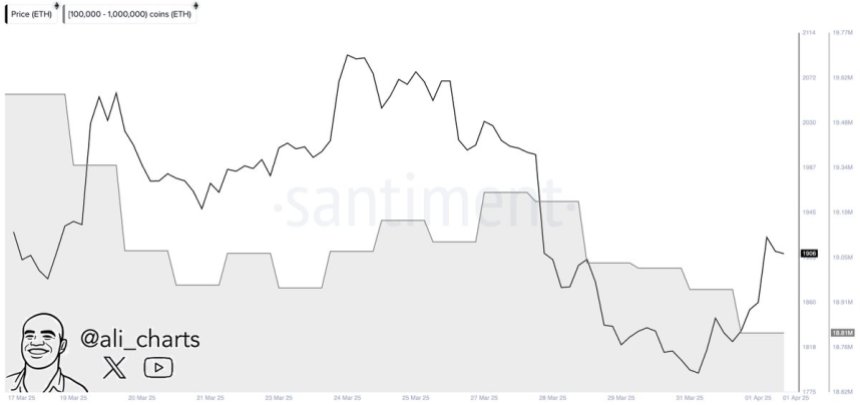
Still, markets are dynamic, and this trend could shift quickly. If Ethereum can hold key support zones and macroeconomic conditions begin to calm, the same large players currently selling may reenter the market in anticipation of the next rally. For now, though, Ethereum remains in a fragile state, with continued selling and cautious sentiment likely to dominate the short-term outlook. Bulls must step in soon to shift the trend — or risk watching ETH slide further in the weeks ahead.
Related Reading
Bulls Struggle to Reclaim Key Levels
Ethereum is currently trading at $1,880 after several days of weak price action, caught in a tight range between $2,000 resistance and $1,750 support. Despite multiple attempts, bulls have failed to reclaim the critical $2,000–$2,200 zone — a level that would signal strength and potentially mark the beginning of a broader recovery phase. Instead, ETH remains trapped in a downtrend, with momentum continuing to favor the bears.
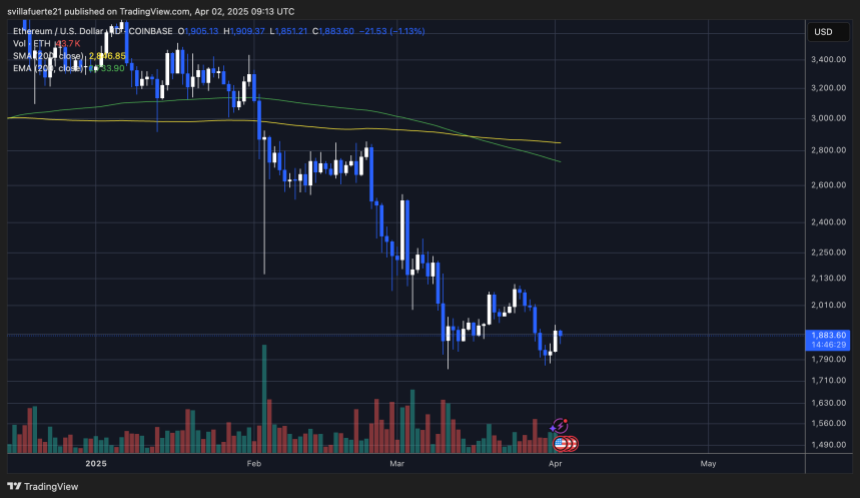
The inability to push higher is putting bulls in a vulnerable position. With Ethereum now hovering just below the $1,900 level, the coming days are crucial. If ETH fails to hold above this mark and cannot break back above $2,000 with conviction, a sharp drop is likely. Such a move could lead to a retest of the lower $1,700s or even deeper, especially if broader market sentiment remains negative.
Related Reading
As macroeconomic instability and market uncertainty persist, investors are growing cautious, and risk appetite continues to fade. For Ethereum to avoid a deeper selloff, bulls must step in quickly, reclaim lost ground, and reestablish confidence above the $2,000 level. Until then, the path of least resistance appears to remain to the downside.
Featured image from Dall-E, chart from TradingView
Ethereum
Ethereum Founder Buterin Funds Swiss Project With 274 ETH—What’s The Agenda?


Ethereum co-founder Vitalik Buterin has again made the news with a big donation to a Swiss project called Zuitzerland. Isla, a Web3 researcher developing the project, received the 274 ETH, equivalent to around $500,000, from Buterin, according to reports. The donation was identified by Onchain Lens, a blockchain monitoring site that tracks fund transfers.
This step is not surprising to anyone who has known about Buterin’s charitable activities and experimental associations. Zuitzerland is said to be a product of Buterin’s previous Zuzalu experiment, whose purpose was to unite like-minded people and engage into proposals on technology, longevity, and decentralized regimes.
Ethereum Donation: What Is Zuitzerland?
The Zuitzerland initiative is based on the ideas launched in the Zuzalu experiment, a short-term community project initiated by Buterin between March and May 2023, in Montenegro. Zuzalu assembled about 200 participants who worked and lived together for two months. They exchanged ideas and teamed up on projects together in workshops, discussions, and social gatherings.
Just in: Vitalik (@VitalikButerin) has sent 274.1 $ETH ($500k), as a grant or donation to a contract deployed by @0xisla, who is building @zuitzerland.
Vitalik’s Address: 0xd8da6bf26964af9d7eed9e03e53415d37aa96045
Contract Address: 0x69649512c97c630c4f06a21e09e71f0362ca74ec… pic.twitter.com/NusZDSp7tn
— Onchain Lens (@OnchainLens) April 1, 2025
Zuitzerland pushes this concept further by hosting residencies, hackathons, and citywide events for those with common interests. The platform emphasizes the development of collaboration between “thinkers and builders.” Although Buterin is not among the founders of the project, he is mentioned as a speaker and curator on its official site, indicating his support and engagement.

Funding Through Token Sales
Buterin’s contribution was partly financed by selling tokens he had earlier received as gifts from other crypto projects. According to on-chain statistics, Buterin sold 5,000 Dohrnii (DHN) tokens for $93,882 and 2 trillion LEDOG (DOG) tokens for $16,569 on March 31, 2025. The proceeds from these sales were aggregated and then sent as 274 ETH to Isla.
ETHUSD trading at $1,873 on the daily chart: TradingView.com
This is not the first time that Buterin has sold tokens gifted to him for a cause. In 2022, he sold some Shiba Inu (SHIB) tokens gifted to him in order to donate to an Indian COVID-19 relief fund. Buterin has also publicly urged token issuers to give directly to charities instead of donating tokens to him.
A History Of Token Donations
Dohrnii Labs, the developers of the DHN token, had sent 10,000 tokens to Buterin in January 2025. Likewise, LEDOG’s developers sent 10 trillion DOG tokens to him in August 2024. Although these tokens are usually given as a token of appreciation, they are also a marketing strategy for visibility. Buterin has been selling these tokens gradually over time, using the funds for donations and other things.
As of now, Buterin still retains 2 trillion DOG tokens, as per data on the blockchain. Nevertheless, his actions reveal a distinct orientation towards leveraging such assets to help initiatives such as Zuitzerland, which align with his belief in decentralized governance and innovation led by community.
Featured image from Gemini Imagen, chart from TradingView

Editorial Process for bitcoinist is centered on delivering thoroughly researched, accurate, and unbiased content. We uphold strict sourcing standards, and each page undergoes diligent review by our team of top technology experts and seasoned editors. This process ensures the integrity, relevance, and value of our content for our readers.
-

 Bitcoin22 hours ago
Bitcoin22 hours agoBitcoin Could Serve as Inflation Hedge or Tech Stock, Say Experts
-

 Market22 hours ago
Market22 hours agoSUI Price Stalls After Major $147 Million Token Unlock
-

 Market21 hours ago
Market21 hours agoBeInCrypto US Morning Briefing: Standard Chartered and Bitcoin
-

 Market20 hours ago
Market20 hours agoAnalyst Reveals ‘Worst Case Scenario’ With Head And Shoulders Formation
-

 Market18 hours ago
Market18 hours agoBitcoin Price Bounces Back—Can It Finally Break Resistance?
-

 Regulation8 hours ago
Regulation8 hours agoKraken Obtains Restricted Dealer Registration in Canada
-

 Altcoin4 hours ago
Altcoin4 hours agoHere’s Why This Analyst Believes XRP Price Could Surge 44x
-

 Market23 hours ago
Market23 hours agoCircle Files for IPO






















